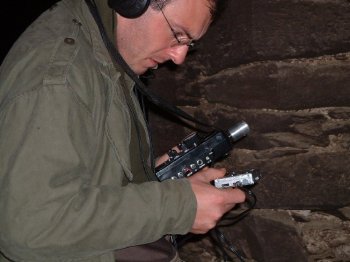Bats become active in spring, having hibernated in a winter roost from November onwards during which they wake up only during mild spells to eat or drink. They then congregate together in colonies, some of which are nursery or maternity roosts in which their babies are born. Bat "pups" are independent six to seven weeks after birth when they are able to catch sufficient insects for survival.
A bat may live to up to forty years or more, if fortunate, but most will die in their first year and the average age is four.
If it is necessary to pick up a bat, gloves should be worn or the bat should be wrapped in a tea towel or cloth, as bats can nip if frightened

Bat Detecting
When the Dower House at Emo Court was to be renovated and turned into a Tea Rooms in 2006, the OPW commissioned surveys to establish the presence, species, and numbers of bats in residence. Of the ten species of bat known to breed in Ireland, three of these have been found at Emo Court: the soprano pipistrelle, Leisler's bat, and the brown long-eared bat.
Top of Page
Bat Conservation, Ireland
This is one of Ireland's smallest bat species, and it gets its name from the very high pitch of its sounds. It is often found roosting in confined spaces in houses and occupies the under-roof space of the Dower House at Emo. The pipistrelle may eat as many as 3,500 midges and small insects in one night. In July 2006, during the survey, 357 soprano pipistrelle bats were counted emerging from the roost at the Dower House. In 2008, 426 were counted.
Top of Page

Common Pipistrelle Bat
This is the largest of the Irish bats and usually one of the first to emerge at dusk. At Emo in July 2006, 205 Leisler's bats were observed leaving the roost in a cottage near the stables. As this bat is rare in Britain and Europe, this maternity roost is deemed to be of national, if not international, importance.

Leisler's Bat
A further bat roost was observed in the basement of the main house during the survey, where approximately ten brown long-eared bats were noted in the cellars. The large ears of this bat are remarkable - almost as long as the body. The brown long-eared bat likes to eat larger prey such as moths as well as other insects.
Top of Page

Brown Long-Eared Bat